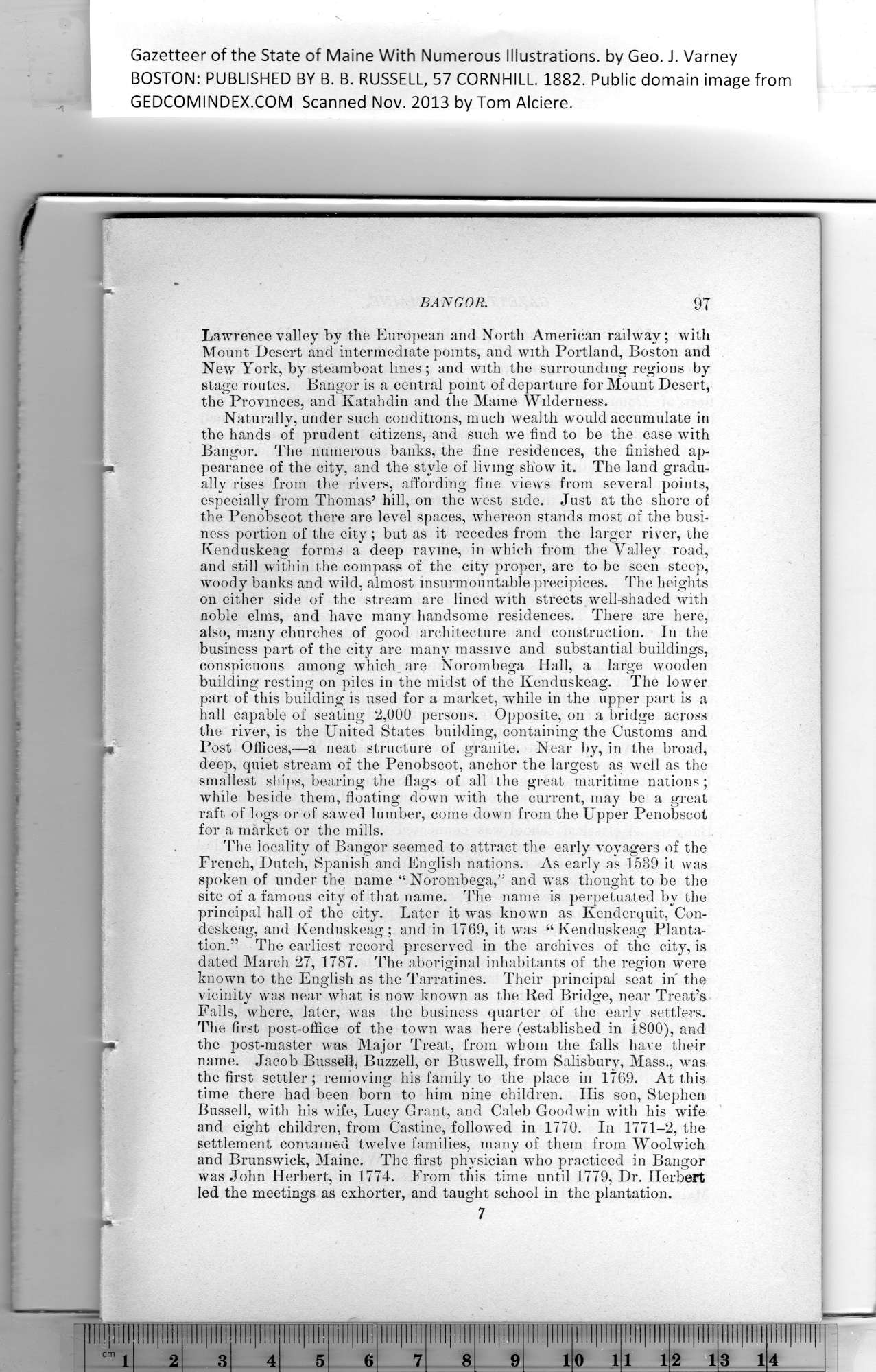|
Gazetteer of the State of Maine With Numerous Illustrations, by Geo. J. Varney
BOSTON: PUBLISHED BY B. B. RUSSELL, 57 CORNHILL. 1882. Public domain image from
BANGOR.
Lawrence valley by the European and North American railway; with
Mount Desert and intermediate points, and with Portland, Boston and
New York, by steamboat lines ; and with the surrounding regions by
stage routes. Bangor is a central point of departure for Mount Desert,
the Provinces, and Katahdin and tbe Maine Wilderness.
Naturally, under such conditions, much wealth would accumulate in
tbe hands of prudent citizens, and such we find to be the case with
Bangor. The numerous banks, the fine residences, the finished ap-
pearance of the city, and the style of living show it. The land gradu-
ally rises from the rivers, affording fine views from several points,
especially from Thomas’ hill, on the west side. Just at the shore of
the Penobscot there are level spaces, whereon stands most of the busi-
ness portion of the city; but as it recedes from the larger river, the
Kenduskeag forms a deep ravine, in which from the Valley road,
and still within the compass of the city proper, are to be seen steep,
woody banks and wild, almost insurmountable precipices. The heights
on either side of the stream are lined with streets well-shaded with
noble elms, and have many handsome residences. There are here,
also, many churches of good architecture and construction. In the
business part of the city are many massive and substantial buildings,
conspicuous among which are Norombega Hall, a large wooden
building resting on piles in the midst of the Kenduskeag. The lower
part of this building is used for a market, while in the upper part is a
hall capable of seating 2,000 persons. Opposite, on a bridge across
the river, is the United States building, containing the Customs and
Post Offices,—a neat structure of granite. Near by, in the broad,
deep, quiet stream of the Penobscot, anchor the largest as well as the
smallest ships, bearing the flags of all the great maritime nations ;
while beside them, floating down with the current, may be a great
raft of logs or of sawed lumber, come down from the Upper Penobscot
for a market or the mills.
The locality of Bangor seemed to attract the early voyagers of the
French, Dutch, Spanish and English nations. As early as 1539 it was
spoken of under the name “ Norombega,” and was thought to be the
site of a famous city of that name. The name is perpetuated by the
principal hall of the city. Later it was known as Kenderquit, Con-
deskeag, and Kenduskeag; and in 1769, it was “Kenduskeag Planta-
tion.” The earliest record preserved in the archives of the city, is
dated March 27, 1787. The aboriginal inhabitants of the region were
known to the English as the Tarratines. Their principal seat in the
vicinity was near what is now known as the Red Bridge, near Treat’s
Falls, where, later, was the business quarter of the early settlers.
The first post-office of the town was here (established in 1800), and
the post-master was Major Treat, from whom the falls have their
name. Jacob Bussell; Buzzell, or Buswell, from Salisbury, Mass., was
the first settler; removing his family to the place in 1769. At this
time there had been born to him nine children. His son, Stephen
Bussell, with his wife, Lucy Grant, and Caleb Goodwin with his wife
and eight children, from Castine, followed in 1770. In 1771-2, the
settlement contained twelve families, many of them from Woolwich
and Brunswick, Maine. The first physician who practiced in Bangor
was John Herbert, in 1774. From this time until 1779, Dr. Herbert
led the meetings as exhorter, and taught school in the plantation.
7
PREVIOUS PAGE ... NEXT PAGE
This page was written in HTML using a program written in Python 3.2
|
